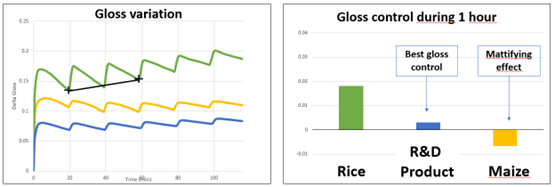Introduction
In the cosmetics industry, the quest for products with effective anti-acne, anti-seborrheic, and mattifying properties is relentless. Both cosmetic brands and ingredient manufacturers face significant challenges in evaluating these effects accurately and efficiently.Traditional methods, while useful, often suffer from limitations such as variability in human skin types and reproducibility issues. Microfactory addresses these challenges with its groundbreaking U-Skin™ technology, which leverages an innovative artificial skin model to mimic human sebum and sweat production.
For its mattifying performance, Lucas Meyer chose to evaluate a new R&D ingredient using U-Skin™.
The innovation of U-Skin™: development of a sebum-mimetic artificial skin
Microfactory’s U-Skin™ technology stands out as a revolutionary advancement in cosmetic testing. U-Skin™ combines a sebum-mimetic artificial skin with advanced microfluidic systems to create a standardized, reproducible platform for evaluating cosmetic products. There are many areas of application, from face care to make-up and dry shampoos. Let’s delve into how this technology works and the impact it has on the industry.
Technological Components and Mechanisms:
- Synthetic Epidermis and Dermis: The artificial skin comprises biocompatible polymers that replicate the texture, elasticity, and permeability of natural human skin. These layers are crucial for mimicking the barrier function and mechanical properties of real skin.
- Artificial Sebaceous Glands: Integrated microfluidic systems simulate sebum production. These systems can vary sebum secretion in response to different stimuli, closely mimicking the dynamic nature of human skin. The artificial sebaceous glands ensure that sebum production and flow are realistically replicated.
- Sebum-like Fluids: The sebum-mimetic fluids used in U-Skin™ closely resemble the chemical composition of natural sebum, including lipids, fatty acids, and triglycerides. This ensures that the interactions between cosmetic powders and sebum are realistic, providing accurate data on product performance.

Evaluating mattifying products with U-Skin™: the example of powders (a study performed in partnership with Lucas Meyer Cosmetics).
U-Skin™ technology allows for precise simulation of sebum production through controlled liquid pulses. Each pulse is followed by a waiting period during which the cosmetic product absorbs the liquid.
This process causes a rapid increase in gloss with each pulse, which then decreases during the waiting period.
After several cycles, if the average gloss increases, it indicates low absorption capacity, suggesting that the powder lacks mattifying power. Conversely, if the gloss remains stable or decreases, it confirms the powder’s ability to control gloss or even provide a mattifying effect. Notably, three cycles in this simulation are equivalent to 24 hours in real life.
This methodology was applied to test three powder samples: Rice, Maize, and a powder under development. The results demonstrated varying capacities of these powders to control gloss, providing valuable insights into their effectiveness.

Benefits for cosmetic ingredient manufacturers
For manufacturers of cosmetic ingredients, U-Skin™ technology offers several key benefits:
- Accurate screening: Enables precise screening of functional ingredients, providing reliable data on their performance.
- Cost-Efficiency: Reduces time and costs associated with traditional testing methods.
- Enhanced reproducibility: Provides standardized and reproducible results, ensuring consistent data across tests.
Advantages for cosmetic brands
Cosmetic brands seeking to reformulate their products with more natural ingredients or to eliminate certain components can significantly benefit from U-Skin™ technology. It allows them to:
- Rapidly test new formulations: Evaluate new formulations efficiently before moving to in vivo testing.
- Ensure product efficacy: Guarantee that reformulated products meet high-performance standards for mattifying effects.
Conclusion
Microfactory’s U-Skin™ represents a significant advancement in the cosmetic industry, providing a reliable and efficient method for testing the efficacy of mattifying products. By closely mimicking human skin, this technology offers unparalleled insights into product performance, helping manufacturers and brands develop superior cosmetic products.
We would like to thank Lucas Meyer, and especially Audrey MANIERE
( Audrey.Maniere@lucasmeyercosmetics.com ).
By adopting these innovative testing methods, the cosmetic industry can continue to push the boundaries of product development, ensuring that consumers receive high-quality, effective products.
CONTACT
Fabrice Monti
CEO Microfactory
site: www.microfactory.eu
email: fabrice.monti@microfactory.eu






